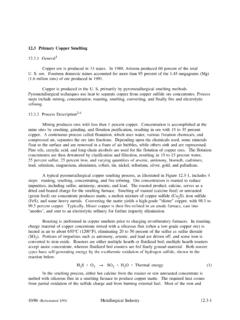Transcription of Chapter - INTRODUCTION TO NANOMATERIALS
1 Chapter - INTRODUCTION TO NANOMATERIALS A. Alagarasi 1. INTRODUCTION NANOMATERIALS are cornerstones of nanoscience and nanotechnology. Nanostructure science and technology is a broad and interdisciplinary area of research and development activity that has been growing explosively worldwide in the past few years. It has the potential for revolutionizing the ways in which materials and products are created and the range and nature of functionalities that can be accessed. It is already having a significant commercial impact, which will assuredly increase in the future. Fig. 1. Evolution of science and technology and the future What are NANOMATERIALS ? Nanoscale materials are defined as a set of substances where at least one dimension is less than approximately 100 nanometers.
2 A nanometer is one millionth of a millimeter - approximately 100,000 times smaller than the diameter of a human hair. NANOMATERIALS INTRODUCTION to NANOMATERIALS of interest because at this scale unique optical, magnetic, electrical, and other properties emerge. These emergent properties have the potential for great impacts in electronics, medicine, and other fields. Fig. 2. Nanomaterial (For example: Carbon nanotube) Where are NANOMATERIALS found? Some NANOMATERIALS occur naturally, but of particular interest are engineered NANOMATERIALS (EN), which are designed for, and already being used in many commercial products and processes. They can be found in such things as sunscreens, cosmetics, sporting goods, stain-resistant clothing, tires, electronics, as well as many other everyday items, and are used in medicine for purposes of diagnosis, imaging and drug delivery.
3 Engineered NANOMATERIALS are resources designed at the molecular (nanometre) level to take advantage of their small size and novel properties which are generally not seen in their conventional, bulk counterparts. The two main reasons why materials at the nano scale can have different properties are increased relative surface area and new quantum effects. NANOMATERIALS have a much greater surface area to volume ratio than their conventional forms, which can lead to greater chemical reactivity and affect their strength. Also at the nano scale, quantum effects can become much more important in determining the materials properties and characteristics, leading to novel optical, electrical and magnetic behaviours. NANOMATERIALS are already in commercial use, with some having been available for several years or decades.
4 The range of commercial products available today is very broad, including stain-resistant and wrinkle-free textiles, cosmetics, sunscreens, electronics, paints and varnishes. Nanocoatings and nanocomposites are finding uses in Book title consumer products, such as windows, sports equipment, bicycles and automobiles. There are novel UV-blocking coatings on glass bottles which protect beverages from damage by sunlight, and longer-lasting tennis balls using butyl-rubber/nano-clay composites. Nanoscale titanium dioxide, for instance, is finding applications in cosmetics, sun-block creams and self-cleaning windows, and nanoscale silica is being used as filler in a range of products, including cosmetics and dental fillings.
5 2. Advances in NANOMATERIALS The history of NANOMATERIALS began immediately after the big bang when Nanostructures were formed in the early meteorites. Nature later evolved many other Nanostructures like seashells, skeletons etc. Nanoscaled smoke particles were formed during the use of fire by early humans. The scientific story of NANOMATERIALS however began much later. One of the first scientific report is the colloidal gold particles synthesised by Michael Faraday as early as 1857. Nanostructured catalysts have also been investigated for over 70 years. By the early 1940 s, precipitated and fumed silica nanoparticles were being manufactured and sold in USA and Germany as substitutes for ultrafine carbon black for rubber reinforcements. Nanosized amorphous silica particles have found large-scale applications in many every-day consumer products, ranging from non-diary coffee creamer to automobile tires, optical fibers and catalyst supports.
6 In the 1960s and 1970 s metallic nanopowders for magnetic recording tapes were developed. In 1976, for the first time, nanocrystals produced by the now popular inert- gas evaporation technique was published by Granqvist and Buhrman. Recently it has been found that the Maya blue paint is a nanostructured hybrid material. The origin of its color and its resistance to acids and biocorrosion are still not understood but studies of authentic samples from Jaina Island show that the material is made of needle-shaped palygorskite (clay) crystals that form a superlattice with a period of nm, with intercalates of amorphous silicate substrate containing inclusions of metal (Mg) nanoparticles. The beautiful tone of the blue color is obtained only when both these nanoparticles and the superlattice are present, as has been shown by the fabrication of synthetic samples.
7 INTRODUCTION to NANOMATERIALS Today nanophase engineering expands in a rapidly growing number of structural and functional materials, both inorganic and organic, allowing to manipulate mechanical, catalytic, electric, magnetic, optical and electronic functions. The production of nanophase or cluster-assembled materials is usually based upon the creation of separated small clusters which then are fused into a bulk-like material or on their embedding into compact liquid or solid matrix materials. nanophase silicon, which differs from normal silicon in physical and electronic properties, could be applied to macroscopic semiconductor processes to create new devices.
8 For instance, when ordinary glass is doped with quantized semiconductor ''colloids,'' it becomes a high performance optical medium with potential applications in optical computing. 3. Classification of NANOMATERIALS NANOMATERIALS have extremely small size which having at least one dimension 100 nm or less. NANOMATERIALS can be nanoscale in one dimension (eg. surface films), two dimensions (eg. strands or fibres), or three dimensions (eg. particles). They can exist in single, fused, aggregated or agglomerated forms with spherical, tubular, and irregular shapes. Common types of NANOMATERIALS include nanotubes, dendrimers, quantum dots and fullerenes. NANOMATERIALS have applications in the field of nano technology, and displays different physical chemical characteristics from normal chemicals ( , silver nano, carbon nanotube, fullerene, photocatalyst, carbon nano, silica).
9 According to Siegel, Nanostructured materials are classified as Zero dimensional, one dimensional, two dimensional, three dimensional nanostructures. Fig. 3. Classification of NANOMATERIALS (a) 0D spheres and clusters, (b) 1D nanofibers, wires, and rods, (c) 2D films, plates, and networks, (d) 3D NANOMATERIALS . Book title NANOMATERIALS are materials which are characterized by an ultra fine grain size (< 50 nm) or by a dimensionality limited to 50 nm. NANOMATERIALS can be created with various modulation dimensionalities as defined by Richard W. Siegel: zero (atomic clusters, filaments and cluster assemblies), one (multilayers), two (ultrafine-grained overlayers or buried layers), and three (nanophase materials consisting of equiaxed nanometer sized grains) as shown in the above figure 3.
10 4. Why are NANOMATERIALS important? These materials have created a high interest in recent years by virtue of their unusual mechanical, electrical, optical and magnetic properties. Some examples are given below: (i) Nanophase ceramics are of particular interest because they are more ductile at elevated temperatures as compared to the coarse-grained ceramics. (ii) Nanostructured semiconductors are known to show various non-linear optical properties. Semiconductor Q-particles also show quantum confinement effects which may lead to special properties, like the luminescence in silicon powders and silicon germanium quantum dots as infrared optoelectronic devices. Nanostructured semiconductors are used as window layers in solar cells.














